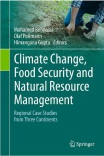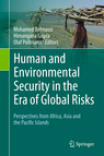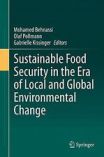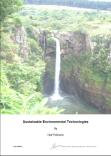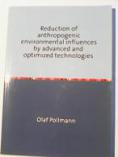
Literatur
All books can be ordered directly at IBP² !
This book contributes to the on-going debates on climate change by focusing on the SDGs and exploring linkages between environmental change and food security as well as the relevance and need to
consider the management of natural resources, especially water, soil and forest.
Compared to relevant existing publications, this book covers case studies that capture the everyday realities of the local people and how they react and adapt to similar situations in different
geographical settings. Each case study presented in this book gives a particular message. The strength of this book lies in the fact that it covers the most neglected topics in climate negotiations
in spite of the fact that these decide the fate of millions of people around the world, especially the developing countries. By presenting a collection of case studies from Africa, Asia and Europe,
this book encourages cross-continental knowledge sharing. The scope
of the book ranges from impacts to mitigation and from in-field experiments to policy implementation. It contributes to the existing knowledge on climate-food nexus and connects climate change to
sectors it could impact directly. All chapters in this book emphasise local ownership of strategy processes, effective participation from all levels, and high-level commitment. Besides being relevant
for the academicians and scholars working in the field of climate change, forest and agriculture, it aims to catch interest of the policy makers and practitioners to understand ground realities for
appropriate action.
Mohamed Behnassi, Himangana Gupta, Olaf Pollmann (Editors)
"Human and Environmental Security in the Era of Global Risks - Perspectives from Africa, Asia and the Pacific Islands",
ISBN 978-3-319-92827-2 (Hardcover), ISBN 978-3-319-92828-9 (eBook),
© Springer International Publishing 2019
Price: 128,- €
This book discusses ways to deepen the debate on the linkages between global risks and human and environmental security. The approach put forward in this book is one of questioning the ability of
existing concepts, regulatory frameworks, technologies and decision-making mechanisms to accurately deal with emerging risks to human and environmental security, and to act in the direction of
effectively managing their impacts and fostering the resilience of concerned systems and resources. Empirical research findings from Africa, Asia and the Pacific Islands are provided.
During the last decades the links between emerging risks and the security of humans and nature have been the object of considerable research and deliberations. However, it is only recently becoming
an important focus of policy making and advocacy. In this contributed volume, it is presumed that the ability – or lack thereof – to make innovative conceptual frameworks, institutional and policy
arrangements, and technological advances for managing the current emerging risks, will foster or undermine the environmental security, and consequently determine the future human security. Moreover,
taking into account the links between environmental/climate security, human security and sustainability will help frame a new research agenda and potentially develop a broad range of responses to
many delicate questions.
This volume discusses a broad range of vital issues encompassing the production and consumption of food in the current period of climate change. All of these add up to looming, momentous challenges to food security, especially for people in regions where malnutrition and famine have been the norm during numerous decades. Furthermore, threats to food security do not stop at the borders of more affluent countries – governance of food systems and changes in eating patterns will have worldwide consequences. The book is arranged in four broad sections. Part I, Combating Food Insecurity: A Global Responsibility opens with a chapter describing the urgent necessity for new paradigm and policy set to meet the food security challenges of climate change. Also in this section are chapters on meat and the dimensions of animal welfare, climate change and sustainability; on dietary options for mitigating climate change; and the linkage of forest and food production in the context of the REDD+ approach to valuation of forests. Part II, Managing Linkages between Climate Change and Food Security offers a South Asian perspective on Gender, Climate Change and Household Food Security; a chapter on food crisis in sub-Saharan Africa; and separate chapters on critical issues of food supply and production in Nigeria, far-Western Nepal and the Sudano-Sahelian zone of Cameroon. Part III examines Food Security and patterns of production and consumption, with chapters focused on Morocco, Thailand, Bahrain, Kenya and elsewhere. The final section discusses successful, innovative practices, with chapters on Food Security in Knowledge-Based Economy; Biosaline Agriculture in the Gulf States; Rice production in a cotton zone of Benin; palm oil in the production of biofuel; and experiments in raised-bed wheat production. The editors argue that technical prescriptions are insufficient to manage the food security challenge. They propose and explain a holistic approach for adapting food systems to global environmental change, which demands the engagement of many disciplines – a new, sustainable food security paradigm.
Sustainability is a very wide and expansive term which needs to be defined very clear and exact to understand it in the right context. Therefore the introduction will give the basis for the
understanding of the term “sustainability” and the global context of use and a more detailed background. The term sustainability has its roots in forestry – “don’t cut more wood than the forest can
produce”. The word sustainability is derived from the Latin sustinere (tenere = to hold; sus = up). Dictionaries provide more than ten meanings for sustain, the main ones being to "maintain",
"support", or "endure” [Onions, 1964]. However, since the 1980s
sustainability has been used more in the sense of human sustainability on planet Earth and this has resulted in the most widely quoted definition of sustainability and sustainable development, that
of the Brundtland Commission of the United Nations
on March 20, 1987. Sustainability is the capacity to endure. For humans, sustainability is the long-term maintenance of responsibility, which has environmental, economic, and social dimensions, and
encompasses the concept of stewardship, the responsible management of resource use. In ecology, sustainability describes how biological systems remain diverse and productive over time, a necessary
precondition for human well-being. Long-lived and healthy wetlands and forests are examples of sustainable biological systems.
Sustainable development and resource efficiency are the common global strategies of the 21st century. The actual global natural resource consumption of humankind went far over the limit and to cover this worldwide resource consumption the productivity of 1.5 earths is now necessary. The work “Reduction of anthropogenic environmental influences by advanced and optimized technologies” discussed the problem of advanced resource efficiencies with mining activities in South Africa as an example. Related strategies to reverse anthropogenic impacts to such an extent that it resembles former natural conditions were also discussed. Heavy metal contaminated soil and water were treated with natural techniques and different natural media to reduce and eliminate contamination and to provide a market value for former unusable material. Specially developed soil ameliorants and natural filter media could increase the total quality of soil and water. Even plants could be established in these changed conditions. Applied to the natural environment an overall upgrade of mining activities could be achieved. To optimize these laboratory and field results support was generated by using evolutionary algorithms as part of the artificial intelligence. By combining applied technologies with the evolution strategy an optimization tool could be developed to simulate, optimize and forecast procedures of anthropogenic impact reversion. With this tool a transfer of solutions to other similar applications in under-developed and developing countries could be shown. The trans-disciplinary scientific approach of balancing the trigger element carbon proved that the reduction to the smallest common element carbon can be used to balance processes and to indicate pollution. As stated in the United Nations Framework, carbon balances are one of the most significant causes of environmental problems, including environmental pollution and health and are also closely related to climate change in general. With carbon balances resource efficiency and resource protection can be transferred into practice. Finally, all results were collected and verified in a decision support system with the aim to optimize the treatment steps and to make the results transparent and available for users in academia and practice. The work was exemplary in showing that the approach of environmental sciences and techniques to reverse anthropogenic interferences back to natural sustainability and evolution, optimized the equilibrium of nature.
By optimising anthropogenic material streams for the example of paper recycling the process steps of paper production and paper recycling are analysed and reduced to the tracer carbon. Carbon was chosen as a tracer because it is not more reducible and in spite of reaction it appears in all steps of the process. The passing of the tracer carbon in the process of production is detected by the balance of carbon and finally compared with results of the optimisation. Evolutionary algorithms are used as a sub range of artificial intelligence to calculate the optimisation of anthropogenic material streams. The advantage of this method is the rapid and precise search of the local and global optima of the discussed optimisation problem. By using this method the biological model of inherits with mutation, recombination and selection, the optimisation calculates one of the best results of the large amount of potential solutions. With this procedure the quota of wastepaper used in the practice production was verified and potentials of optimisation are pointed out. Because of the defective calculation by evolutionary algorithms a validation by comparative calculation – in this case by Nelder-Mead-Optimisation-Algorithm – is necessary. For inductive method of proof the banana-function by Rosenbrock – as a general optimisation problem – was additionally calculated by evolutionary algorithms. With this the usability of evolutionary algorithms was proofed and verified for modelling anthropogenic material streams. The result of optimising the paper recycling was an improvement of the rate of waste paper in two different paper brands by keeping the equal quality. The same result was shown by the formulation of balance by means of the tracer carbon. Because of the correlation of the fibre length and the carbon part it is possible to compare the formulation of balance with the formulation of calculation. The result of waste paper components confirm with the results of the balance of carbon. By comparing the relation of secondary fibres to fresh fibres including auxiliary material it could be shown that the increased use of waste paper raised the relation of carbon as well as the relation of quantity only insignificant. The implementation of the example of paper recycling has shown that sub ranges of anthropogenic produced material streams can be optimised by the use of evolutionary algorithms. In many other range of uses is secondary material created of anthropogenic metabolism. This secondary material can be optimised by using evolutionary algorithms as well. With this research the possibility of using evolutionary algorithms to optimise different anthropogenic material streams, which produce secondary material was proofed.

